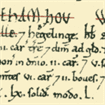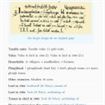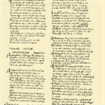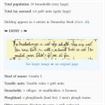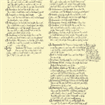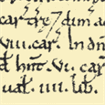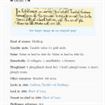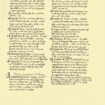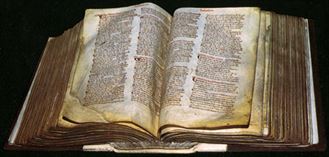
“William sent his men all over England, into every shire to find out how many hundred hides there were and what land and cattle the King himself had in the country. So very narrowly did he have it investigated that there was no single hide, nor ox, nor cow or one single pig that was not put down in his record.” So wrote Orderic Vitalis about the Domesday Book completed on Lammas Day 1086.
http://www.nationalarchives.gov.uk/domesday/
http://www.nationalarchives.gov.uk/domesday/discover-domesday/
“Domesday is our most famous and earliest surviving public record. It is a highly detailed survey and valuation of land holding and resources in late 11th century England. The survey was a massive enterprise, and the record of that survey, Domesday Book, was a remarkable achievement. There is nothing like it in England until the censuses of the 19th century.
“In 1066 William Duke of Normandy defeated the Anglo-Saxon King, Harold II, at the Battle of Hastings and became King of England. In 1085 England was again threatened with invasion, this time from Denmark. William had to pay for the mercenary army he hired to defend his kingdom. To do this he needed to know what financial and military resources were available to him.
“At Christmas 1085 he commissioned a survey to discover the resources and taxable values of all the boroughs and manors in England. He wanted to discover who owned what, how much it was worth and how much was owed to him as King in tax, rents, and military service. A reassessment of the tax known as the geld took place at about the same time as Domesday and still survives for the south west. But Domesday is much more than just a tax record. It also records which manors belonged to which estates and gives the identities of the King’s tenants-in-chief who owed him military service in the form of knights to fight in his army. The King was essentially interested in tracing, recording and recovering his royal rights and revenues which he wished to maximise. It was also in the interests of his chief barons to co-operate in the survey since it set on permanent record the tenurial gains they had made since 1066.
“The word ‘Domesday’ does not appear in the book itself. A book written about the Exchequer in c.1176 (the Dialogus de Sacarrio) states that the book was called ‘Domesday’ as a metaphor for the day of judgement, because its decisions, like those of the last judgement, were unalterable. For many centuries Domesday was regarded as the authoritative register of ancient landholding and was used mainly for that purpose. It was called Domesday by 1180. In the medieval period Domesday was also known as the Winchester Roll or King’s Roll, and sometimes as the Book of the Treasury.”
http://www.bbc.co.uk/history/british/normans/doomsday_01.shtml
~~~~~
The Open Domesday Project makes the text of the Domesday Book freely available; their material can be found at – https://opendomesday.org/place/SK6928/hickling/
These records also include additional information about land ownership (see ‘detail’ pages, above):

